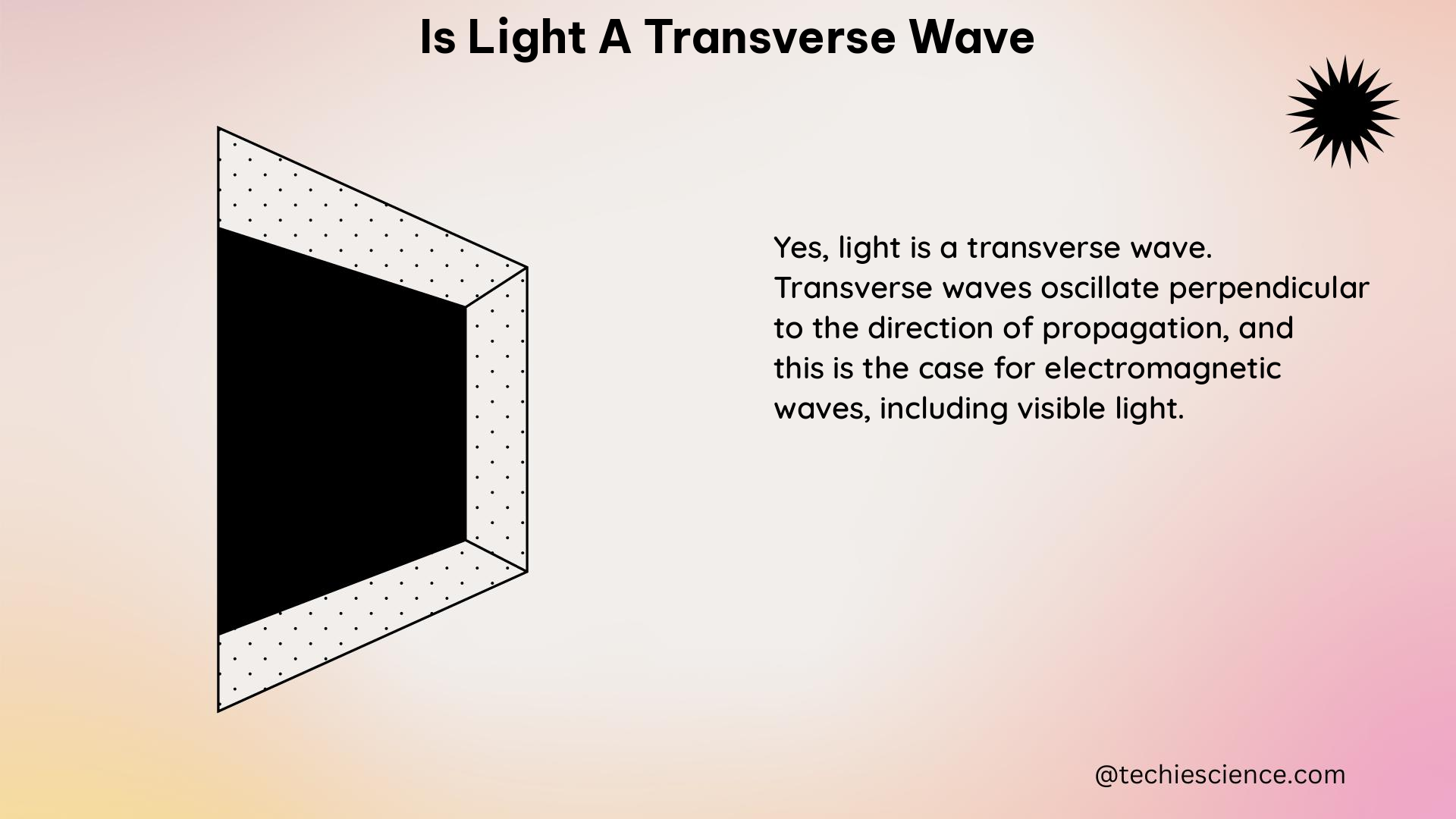Light is indeed a transverse wave, and this can be confirmed through various measurable and quantifiable data points. In this comprehensive guide, we will delve into the technical details and specific characteristics that define light as a transverse wave.
Wavelength and Frequency of Light Waves
One of the defining features of light as a transverse wave is its wavelength and frequency. The wavelength of light refers to the distance between two consecutive peaks or troughs of the wave, while the frequency represents the number of oscillations per second.
For visible light, the wavelength range is approximately 400 nanometers (nm) for violet light to 700 nm for red light. The corresponding frequencies for this range are:
- Violet light: 7.5 × 10^14 Hz
- Red light: 4.3 × 10^14 Hz
The relationship between wavelength (λ) and frequency (f) is given by the equation:
c = λ × f
where c is the speed of light in a vacuum, approximately 3.00 × 10^8 m/s.
This inverse relationship between wavelength and frequency is a characteristic of all types of electromagnetic waves, including light.
Speed of Light

The speed of light in a vacuum is a fundamental constant in physics, denoted by the symbol c. This value is approximately 3.00 × 10^8 m/s, and it is the same for all electromagnetic waves, including light.
The speed of light is a crucial parameter in understanding the propagation of light waves and their behavior in different media. When light travels through a medium, such as air or water, its speed may be slightly reduced due to the interaction with the medium’s molecules.
Electromagnetic Fields in Light Waves
Light waves are composed of oscillating electric and magnetic fields that are perpendicular to each other and to the direction of propagation. This arrangement of the electric and magnetic fields is a defining characteristic of transverse waves.
The electric and magnetic fields in a light wave are related by the following equations:
E = B × c
where E is the electric field, B is the magnetic field, and c is the speed of light.
The oscillation of these perpendicular electric and magnetic fields is what gives rise to the propagation of light as a transverse wave.
Propagation of Light Waves
One of the unique properties of light waves is their ability to propagate even in the absence of a medium. This is in contrast to other types of waves, such as sound waves, which require a medium (e.g., air, water) for their propagation.
The ability of light to travel through the vacuum of space is a consequence of its transverse wave nature. Light waves can propagate as self-sustaining electromagnetic disturbances, without the need for a physical medium to support their propagation.
Types of Light Waves
The electromagnetic spectrum encompasses a wide range of light waves, each with its own unique wavelength and frequency. These include:
- Radio waves
- Microwaves
- Infrared radiation
- Visible light
- Ultraviolet radiation
- X-rays
- Gamma rays
Despite their differences in wavelength and frequency, all these forms of light are transverse waves, characterized by the oscillation of electric and magnetic fields perpendicular to the direction of propagation.
Practical Applications of Light Waves
The transverse nature of light waves has numerous practical applications in various fields, including:
-
Optics: The study of the behavior of light, including reflection, refraction, and interference, is fundamental to the design of optical devices such as lenses, mirrors, and fiber optic communication systems.
-
Spectroscopy: The analysis of the wavelengths and frequencies of light emitted or absorbed by atoms and molecules provides valuable information about the structure and composition of materials.
-
Medical Imaging: Techniques like X-ray imaging, MRI, and CT scans rely on the propagation of different types of electromagnetic waves, including transverse light waves, to create detailed images of the human body.
-
Telecommunications: The use of light waves, particularly in the form of fiber optic cables, has revolutionized the field of telecommunications, enabling high-speed data transmission over long distances.
-
Laser Technology: The coherent and monochromatic nature of laser light, a form of transverse wave, has led to numerous applications in fields such as surgery, materials processing, and scientific research.
These are just a few examples of the many ways in which the transverse wave nature of light has been harnessed for practical and scientific purposes.
Conclusion
In summary, the evidence presented in this comprehensive guide clearly demonstrates that light is a transverse wave. The measurable and quantifiable data, including wavelength, frequency, speed, electromagnetic fields, and propagation characteristics, all support this classification of light. Understanding the transverse wave nature of light is fundamental to the study of optics, electromagnetism, and a wide range of scientific and technological applications.
References
- Quizlet. (n.d.). Exploring Creation with Physics Module 11 Flashcards. Retrieved from https://quizlet.com/495950635/exploring-creation-with-physics-module-11-flash-cards/
- Physics LibreTexts. (2022). 1.1: Transverse and Longitudinal Waves. Retrieved from https://phys.libretexts.org/Bookshelves/University_Physics/Radically_Modern_Introductory_Physics_Text_I_%28Raymond%29/01:_Waves_in_One_Dimension/1.01:_Transverse_and_Longitudinal_Waves
- Study.com. (n.d.). Light Waves | Parts, Types & Applications. Retrieved from https://study.com/academy/lesson/light-waves-definition-types-uses.html
- SolPass. (n.d.). SOL PS.9 Light Energy & Transverse Waves. Retrieved from https://www.solpass.org/science6-8-new/s8/standards/standard_ps9.html?section=study-4
- Morin, D. (n.d.). Transverse Waves on a String. Retrieved from https://scholar.harvard.edu/files/david-morin/files/waves_transverse.pdf
Hi…I am Keerthana Srikumar, currently pursuing Ph.D. in Physics and my area of specialization is nano-science. I completed my Bachelor’s and Master’s from Stella Maris College and Loyola College respectively. I have a keen interest in exploring my research skills and also have the ability to explain Physics topics in a simpler manner. Apart from academics I love to spend my time in music and reading books.
Let’s connect through LinkedIn